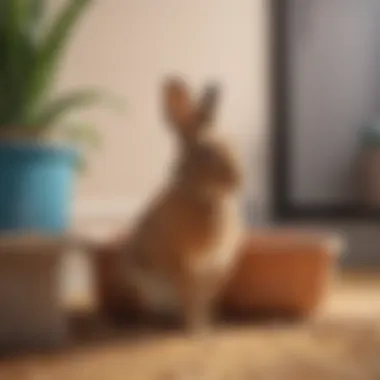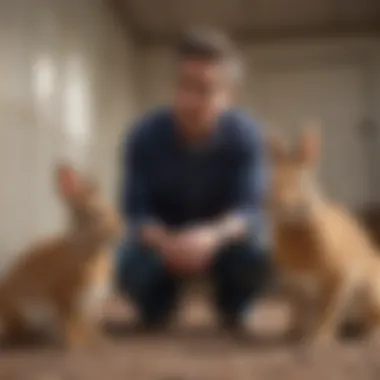Potty Training Your Rabbit: A Complete Guide for Owners


Intro
Potty training a rabbit can seem intimidating for new pet owners. However, understanding basic rabbit behaviors and implementing a consistent routine can pave the path to success. As rabbits are naturally clean animals, they often prefer to keep their living space tidy. With basic insights into their habits, the notion of potty training ceases to be daunting and evolves into an achievable goal.
In this guide, we will examine several aspects essential for effective potty training. From daily care routines and cage setups to behavioral insights, this article covers everything required for creating a clean environment for both you and your rabbit. By following the outlined practices, both new and existing rabbit owners can improve their companion's toilet behavior in no time.
Care Tips
Maintaining a clean living space for your rabbit involves more than just occasional cleaning. Just as people do, rabbits thrive best in organized environments. Ensuring proper routines and setups encourages your rabbit to develop good potty habits quickly.
Daily Care Routines
Daily routines should encompass feeding, grooming, and monitoring their living area. A steadfast schedule provides not only structure but also makes it easier to observe any patterns or behavioral changes. Regular and routine feeding times helps in stabilizing your rabbits' digestive health and room to properly manage potty breaks.
Also, maintaining a calm and interactive environment can notably aid training efforts. Ensuring you spend quality time with your rabbit daily supports bonding and reinforces positive behavior reinforcement.
Cage Setup and Maintenance
A well-organized cage directly impacts your success in potty training. Ensure your cage is spacious, featuring areas for sleeping, eating, and, importantly, a designated toilet area. A corner litter box filled with rabbit-safe bedding can significantly aid in housing area untenable odors.
Replacing litter regularly, at least once a week, or as required according to your pet’s habits, keeps smells controlled and promotes their expected bathroom area’s usage. A thorough maintenance routine motivates your rabbit to further utilize designated areas, as they sense cleanliness and routine.
Hygiene and Cleaning Practices
Maintaining hygiene can never be overstressed. Cleaning the cage is essential but goes beyond mere litter replacement. Use water or mild, rabbit-friendly cleaning agents to wipe down surfaces, removing any residual odors. This can encourage your rabbit to avoid other areas and use their litter box solely.
Additionally, ensure toys and accessories, especially those chewed on, remain clean. A dusty or dirty environment may discourage your rabbit from their potty training efforts.
Seasonal Care Adjustments
Changes in seasons also dictate how underlying care routines might mesh with habits. Colder seasons might result in slower eating or resting, thus shifting potty habits. Conversely, warmer weather can cause changes in the quantity and type of food your rabbit consumes, impacting their bathroom timing and frequency.
Usage of different seasonal bedding can also affect awareness of their space and play roles in potty guidance. Always observe any shifts in behavior due to environmental factors.
Understanding these various care aspects sets a proper foundation for establishing successful potty training.
In the upcoming sections, the focus will shift towards behavioral insights, nutrition guides, health and wellness tips, and recreational enrichment activities, all crucial to ensuring that both your training efforts and the well-being of your rabbit expand positively.
Understanding Rabbit Behavior
Understanding the behavioral characteristics of rabbits is crucial for effective potty training. Rabbits have distinct temperaments and instincts that heavily influence their tendencies to use a litter box. By grasping these behaviors, an owner can create a conducive environment for training and reduce the likelihood of accidents.


The importance of understanding rabbit behavior lies in meeting both their physical and emotional needs. Recognizing what rabbits instinctively do can guide the training process. This can lead to a smoother transition into potty training and overall well-being for the animal. Knowledge of these behaviors modernizes training techniques, allowing for specific adjustments as needed.
Natural Instincts
Rabbits, being prey animals, have natural instincts that dictate their bathroom behaviors. In the wild, they prefer to have a clean and secure living space. This preference is deeply rooted in their instinct to eliminate waste away from their burrows to avoid predators. Here are some key natural instincts to consider when potty training your rabbit:
- Territorial Marking: Rabbits often mark their territory. They can naturally gravitate to specific areas for their droppings.
- Social Grooming: This behavior includes cleaning themselves and their herd. A neat space is essential for their well-being.
- Patterned Elimination: Observing your rabbit can reveal their patterns in bathroom behaviors. This information is invaluable in aiding training efforts.
Understand these instincts well. Rabbits communicate a lot through their bodily cues. Familiarity with signals can help prepare for accidents and ensure proper training approaches are taken.
Social Dynamics of Rabbits
Social dynamics play a significant role in how rabbits behave when introduced to new environments. They are highly social creatures that thrive in a community. Interaction with owners and surrounding pets can affect their bathroom habits. By examining these dynamics, you learn how to foster confidence and reduce stress factors affecting life in the litter box. Here are the aspects to highlight:
- Group Behavior: In bonded pairs or groups, rabbits develop social habits affecting litter use. They may mirror each other's bathroom conduct.
- Environmental Stress: Noise or movement can unsettle a rabbit, influencing its willingness to use its litter box. Notice if accidents occur under stressful circumstances.
- Trust and Comfort: A feeling of safety within their environment enhances positive behaviors. A stress-free space promotes litter box use.
Being aware of social dynamics enhances the potty training experience. Communicating through care can encourage positive mastering board behavior and litter habits. Understanding these broad aspects fosters a well-rounded approach to potty training and rabbit care overall.
Preparation for Potty Training
Potty training a rabbit is not just a matter of placing a litter box in the right spot. Preparation sets the tone for the entire training experience. Having the right elements in place helps your rabbit feel secure, encouraging them to adapt quickly. There are several critical factors to consider that can ease the overall nurturing process.
Selecting a Suitable Litter Box
Choosing the right litter box is fundamental. Ideally, a litter box should be spacious enough for your rabbit to turn and move around. Covered boxes can reduce odor, but many rabbits prefer open spaces. A box size of at least 24 x 18 inches is often suitable for medium to large rabbits. Make sure the entry point is low enough for easy access.
Besides size, you also should take into account the design. Some litter boxes come with high sides to prevent spills, while others have builtin corners solidifying against separation. Pay attention to open vs. closed concepts; some rabbits might enjoy the cover offers privacy, while others will find it confining.
Choosing Appropriate Litter Materials
The choice of litter is as important as the box itself. There are several types available including paper-based, wood pellets, and grass hay. Each has unique benefits. For example:
- Paper-based litters usually absorb moisture well and are biodegradable.
- Wood pellets can control odor effectively and are shelf stable.
- Grass hay merges well into a diet but must be refreshed frequently.
Safety is key. Ensure any litters are non-toxic. Avoid clumping litters made for cats since they can cause gastrointestinal problems if ingested. Observe how your rabbit interacts with the litter to ascertain their preference.
Establishing a Comfortable Environment
Creating a relaxing and trusting environment lays the groundwork for successful potty training. Start by identifying a specific area for the litter box. Place it in a low-traffic zone of your home. Rabbits like privacy, yet they want to observe their surroundings. Pick a balance. Make sure your rabbit has a personal area that still connects with family hubs in your house.
Use familiar items around that space come encourage positive associations. Their favorite chew toys or blankets can help. Moreover, upgrading it with significant personal touches enhances this environment, Encourage exploration but limit distractions. A quiet demeanor from humans in the vicinity can also help your rabbit to settle accordingly.
Binding necessary preparations ensure both you and your rabbit can embark on a productive journey towards potty training success.


With a strong foundation of preparation, your route to a clean and adapted rabbit household should become increasingly straightforward.
Steps to Train Your Rabbit
Potty training can feel overwhelming for new rabbit owners, but a structured approach makes this task simpler and more manageable. It greatly enhances the living environment for both you and your rabbit. Familiarizing your rabbit with their litter box is the foundational step. Understanding this dynamic makes succeeding in potty training possible. A consistent and positive route fosters cooperation and builds trust between you and your rabbit.
Initial Foreword to the Litter Box
The first step in training your rabbit is the introduction of the litter box. This should be done in a calm and routine environment. During this initial phase, place the litter box in an area where your rabbit spends most of their time. This increases the chance of success.
Observe your rabbit's habits. They typically have regular spots where they prefer to relieve themselves. If possible, place the litters box there. You can also use some litter from an area they have already used to create familiarity. This may help your rabbit associate the litter box with their natural behavior. Initiate this step gradually; rushing can create anxiety and confusion.
Rewarding Desired Behavior
Everytime your rabbit uses the litter box successfully, offer them a treat or gentle praise. This reinforces positive behavior drawing on your rabbit's natural inclination to repeat what is rewarded. Use treats such as small pieces of their favorite vegetables. Remember that winter type can lead to confusion; keeping reward choices simple is better.
Give rewards immediately after they use the litter box. This ensures the connection between the behavior and the reward is clear. Over time, your rabbit will start to recognize using the litter box as a good thing, promoting further consistency.
"Positive reinforcement is fundamental to maintaining behavior and minimizing stress during training."
Consistency in Training Routine
Establishing a clear and consistent training routine cannot be overstated. Inevitably your longer the training process takes. However, providing stability is key to success. Potty training a rabbit requires dedication and proper timing. Always place the litter box in the same area and stick to the same commands when encouraging your rabbit to use it.
Keep an eye on their habits. Regular observation provides insight into when they typically feel the need to go, whether it's after eating or playing. Adapt your routine according to their timings. Lengthen the time between bathroom breaks gradually, making adjustments when necessary.
This consistency rewards progress and teaches your rabbit the expected behavior while fostering a supportive atmosphere. Literarily adapting to change helps your rabbit thrive in their new litter habits.
Addressing Common Challenges
When embarking on the journey of potty training rabbits, facing challenges is inevitable. Addressing these common setbacks is crucial for successful training and fostering a harmonious environment for both you and your rabbit. Understanding these challenges will aid owners in implementing effective strategies and minimize frustration. Moreover, compassion and patience are paramount during this training phase. It is critical to remember every rabbit is unique. What works for one may not work for another. The key is to be aware of these challenges and approach them with an open mind.
Refusals to Use the Litter Box
There can be occasions when a rabbit outright refuses to use its litter box. Several reasons may cause this behavior. The selection of the litter box may not suit your rabbit's preferences. It could also be that the litter type is disconcerting or uncomfortable for the rabbit.
To address this issue, consider looking into different types of litter boxes as well as different litter materials. Some rabbits prefer more spacious boxes, while others may be comfortable with covered or lower-entry boxes. Another reason for refusal can stem from territorial behavior or stress. If your rabbit feels anxious about its surroundings, it might not recognize the litter box as a safe place to relieve itself.
A settling-in period can be significant. Once your rabbit feels secure in its environment, this initial refusal often subsides. Be consistent in showing your rabbit the litter box and encourage use gently.
Accidents in the Living Space
Accidents are a reality when it comes to challenging the potty training process. Possibilities are many, and they vary based on individual circumstances. If incidents occur frequently, it might indicate some underlying issues. For example, the placement of the litter box can directly impact its usage. Ensure visibility, accessibility, and cleanliness of the litter box.


If your rabbit frequently has accidents, monitor patterns. This will help you identify where accidents commonly take place. You might find that specific areas become preferred spots. In response, you could place additional litter boxes in those areas while reinforcing the main litter box.
Additionally, avoid scolding your rabbit during cleanup. Thishen creating a negative atmosphere and may contribute to fear or anxiety. Instead, maintain a calm demeanor and use positive reinforcement to encourage correct behavior.
Behavioral Issues During Training
Often, owners will face various behavioral difficulties while training. Such issues encompass urination or defecation outside the litter box. Occasionally, behavioral problems arise due to stress, trust issues, or even health concerns.
Understand that reactions may vary. Some rabbits simply require more time than others to adjust. Patience is essential. Factors outside the litter box, including noise or introduce to other pets, might lead to behavioral troubles.
Engaging in extra interactive time can strengthen your bond. Spending quality time with your rabbit will promote confidence and sense of safety. Gradually introducing distracting elements in their environment can also assist in minimizing stress during training.
Remember, consistency provides reassurance to your rabbit.
In summary, addressing the common challenges encompassed in potty training encourages a more profound understanding of both the animal and the training process itself. Setbacks can be indicative of larger patterns and should prompt corrective actions rather than irritation. Success in potty training hinges on your ability to manage and resolve these challenges sensitively.
Maintaining Litter Box Hygiene
Maintaining hygiene in a rabbit's litter box is crucial for several reasons. Good litter box cleanliness promotes the rabbit's health and encourages consistent use of the box. Ignoring proper hygiene can lead to odor problems, unhygienic living conditions, and potentially harmful health issues for your furry companion. By prioritizing litter box maintenance, you create a more pleasant environment for both you and your rabbit, reducing stress for both parties.
Regular Cleaning Practices
Engaging in regular cleaning practices for your rabbit's litter box ensures that it remains a comfortable and inviting space. It is recommended to change the litter material weekly, or more frequently if it becomes soiled or wet. This not only prevents bad odors, but it helps keep your rabbit safe from disease-causing bacteria. A clean box signals to your rabbit that this is the designated area for elimination.
Some effective cleaning practices include:
- Removing waste daily: Scoop out any droppings and spent litter from the box each day. This simple task prevents odors from building up and encourages your rabbit to continue using the box willingly.
- Wash the litter box frequently: At least every week, empty the entire content and clean the box with lukewarm water and mild soap. Make sure to rinse it thoroughly to avoid leaving any soap residue.
- Dry it completely: After cleaning, ensure the box is dried properly before reintroducing litter. This prevents mold and helps maintain a clean area.
Regular maintenance of the litter box aligns significantly with your rabbit's health, ensuring it remains a safe and safe haven for their natural activities.
Choosing Safe Cleaning Products
When cleaning your rabbit's litter box, it is essential to consider the safety of the cleaning products used. Some common household cleaners contain harsh chemicals that could be harmful or irritating to your pet. Always opt for cleaning solutions that thoroughly disinfect without being overwhelming or toxic. Natural options, such as vinegar or baking soda, can be effective as they are both safe and environmentally friendly.
- Vinegar solution: Mix equal parts water and white vinegar for exceptional cleaning properties without harmful effects. It's an excellent approach for disinfecting.
- Baking soda: This can aid fighting odors when sprinkled in the bottom of the clean litter box.
Be aware of ingredients found in cleaning products. Always verify the labels of commercially sold cleaning supplies to ensure they are rabbit-safe. Prioritizing safe products not only protects your rabbit but also maintains a healthier surrounding for everyone in the exercise.
Keeping a litter box clean is integral to the rabbit's success:** Establishing litter box hygiene improves behavior related to litter use, tracks excellent health, and secures effective habitation.**
To install the proper habits of regularly cleaning and using safe products, you ensure a harmonious and healthy environment for your beloved rabbit. In sum, diligent attention to litter box upkeep is not just part of the process; it’s foundational to successful potty training.
End
Potty training your rabbit involves an investment of time, care, and meticulous observation. Each rabbit possesses unique behaviors and tendencies that influence their learning process. Understanding these characteristics is crucial. Consistent routine is also important. It transforms potty training into a manageable task and easier for the rabbits.
Moreover, the benefits of proper potty training are numerous. A trained rabbit enhances the living arrangement by reducing messy areas. Owners can spend less time cleaning and more time bonding with their pet. However, it is not merely about cleanliness. It is about fostering a stronger relationship between pet and owner. This relationship flourishes when the owner dedicates time, patience, and respect for the rabbit's needs.
The consideration of hygienic practices further solidifies a successful potty training experience. Keeping the litter area hygienic encourages the rabbit to frequent the litter box rather than other places. Above all, adopting a patient mindset throughout this training journey cannot be overstated. Learning to see the world from the rabbit’s perspective is a crucial aspect.















